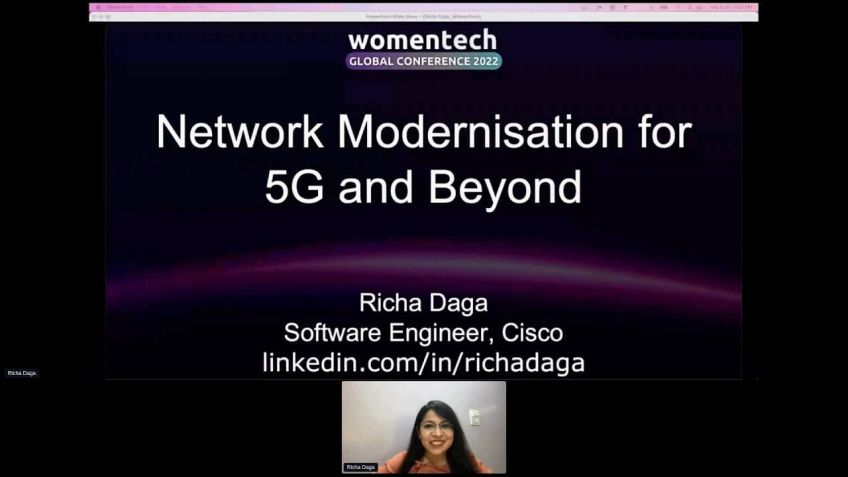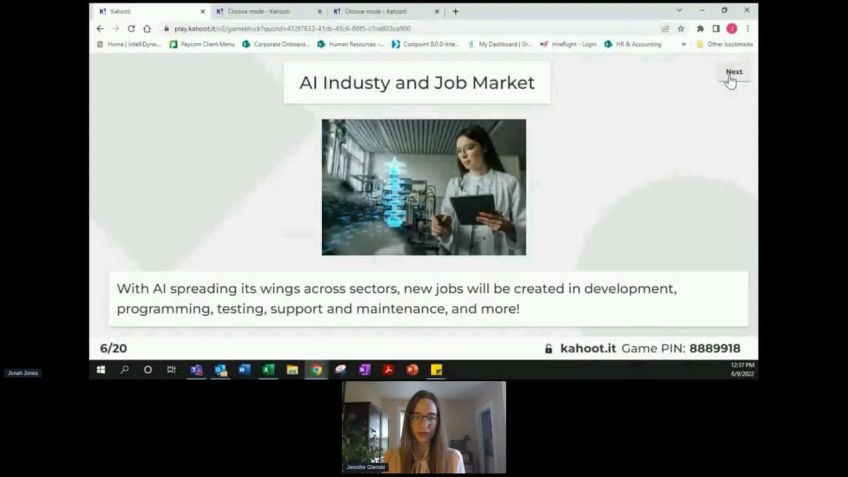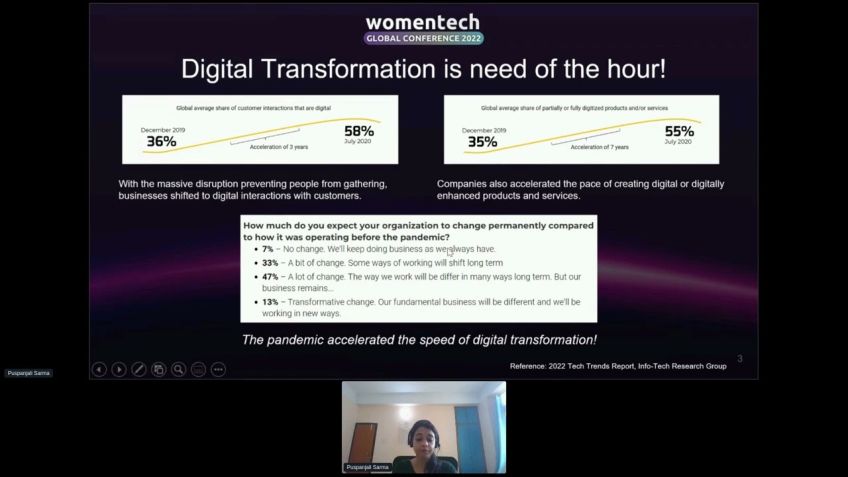Machine learning for Reliable Communication in 5G and 6G wireless systems
Annapurna Pradhan
PhD Research ScholarAn Insight into 5G, 6G Communication and the Role of Machine Learning
Annapurna, a PhD research scholar from India, discusses the revolutionary world of 5G and 6G communication and how Machine Learning (ML) is enabling these futuristic applications.
What is 5G and Why is it Relevant?
We are approaching an era where smart is everything – smart homes, cities, factories of the future, and intelligent transport systems, to name a few. These advanced applications require wireless communication, which is where 5G comes into the picture. It enables devices to communicate reliably and provides necessary connectivity for these applications without lag or glitches.
So, how does it work? 5G offers unique services categorized into three parts:
- Enhanced Mobile Broadband Service: characterized by high broadband data suitable for video streaming, virtual and augmented reality, etc. This service enhances communication between humans and smart devices.
- Massive Machine Type Communication: involving a vast amount of smart devices connecting wirelessly. These devices, like sensors, continuously transmit and receive signals.
- Ultra Reliable Low Latency Communication: providing very high reliability of service, a vital characteristic of 5G.
The Entry of Machine Learning into Wireless Communication
Now, with the fundamental understanding of 5G services, let's dive into how machine learning can be implemented in this landscape.
Machine learning and Artificial Intelligence (AI) have significantly transformed various sectors, including healthcare and chemical engineering. They are now being introduced into wireless communication, offering solutions for complex problem-solving.
Machine learning models fall into three categories:
- Supervised Learning Model: output and input are mapped with some rules. The model extracts features automatically and uses them to provide a classification
- Unsupervised Learning Model: no labels are present. However, models can learn patterns and predict new outputs
- Reinforcement Learning: this model continually learns from the environment, adapts, and acts accordingly to maximize reward
Machine Learning: A Boost for 5G and 6G
The main challenge in wireless communication is the openness of the wireless medium. With machine learning, we can adapt to these variations, provide proactive network information, or allocate resources based on past data. ML models can then solve certain challenges traditional methods could not address, making them suitable for applications like bandwidth allocation, energy efficiency, and traffic prediction.
Challenges and Opportunities in Applying Machine Learning to 5G and 6G
While machine learning brings many benefits, some challenges persist such as data collection, hyperparameter tuning, and security concerns. However, these hurdles can be viewed as opportunities for improvement. Models like Federated Learning provide security at various levels.
Conclusion
5G and 6G will drive the future of wireless communication with machine learning and AI at the center of it all. However, machine learning doesn't need to be applied everywhere. Our aim should be strategically using ML where complexity arises. Despite the challenges, the future looks bright, and ML will indeed play a significant role in these forthcoming communications.
Do you have any questions? Feel free to connect with Annapurna on LinkedIn for any inquiries or clarifications regarding this subject.
Video Transcription
Hello everyone. Hello everyone. I'm Annapurna phd, research scholar from India. So today I will be uh talking about five G and six G communication. Basically the reliable communication in five G and six G where machine learning can play a very important role in enabling those futuristic applications.
So let's get started. So first of all, the five G application, just for the information that what are the five G applications, why we are calling it as a five G application because whatever the applications we are looking around today, those we are approaching an era of futuristic applications like uh factory or future autonomous driving, intelligent transport system, smart home, the smart home and smart city.
So so everything what is smart that needs to communicate with each other, the devices needs to communicate with each other and it requires the wireless communication. So we can see that the application of five G or five G can enable these applications and it can get the connectivity wherever and whenever it is required with some very futuristic key performance indexes offered by five G. So how five G can facilitate these applications like remote surgery and autonomous driving, how it is connected to the base station and everything which is connected that should be reliable. There should not be any lag or glitch and it should be perfect as 99.999%. So this can be only possible by some unique services which which is offered by five G. Those are called, there are, it is categorized into three part what is called enhanced mobile broadband service, which is this service is characterized by high broadband data like uh video streaming, uh HD video streaming live actions. So virtual reality, augmented reality, all these applications and it enables the communication between devices and human and the smart devices. The next type of application and next type of service class is your massive machine type communication. Now, IUT applications are the best example of these.
So what are the massive machine type like a lot of smart devices that connect with each other through wirelessly? So those smart devices like sensors, they continuously transmit and receive signals in between each other. So for example, if you will take a smartphone system, there are sensors embedded into your home appliances. So they will be monitoring each and every uh operation of the appliances and inform you through the mobile app. So that means those sensors are collecting data tra transmitting the data wirelessly and it is dominated through the mobile app. So there is a wireless communication. So when five G comes into picture, it makes this more smooth by increasing the connectivity. So massive communication is uh is characterized by large coverage. Now, the most important part of the five G service classes offer are ultra reliable, low latency communication, ultra reliable means it as I have already told that it is provides very high reliability of service.
Now how it provides the reliability of service, that means if I am sending 1000 data packets at most, one data packet can be in error and all the 999 data packets will be error free. So that that is just an example to make it as a level of low latency, that means whatever communication from the transmitter to receiver will happen that should be within one millisecond time period. So it provides a very faster and reliable support and it is offered by five G and these applications will be, these services will be enabling the next generation like six G mobile services. Now comes to the fundamental of machine learning or A I. Now the artificial intelligence or machine learning, they are just revolutionized all the applications where it has been used, be it from the healthcare to the chemical engineering or any other, any other field. What we know now when it is applied to the wireless communication due to the inherent characteristic of these uh machine learning models that are suitable for complex problem solving. So we are motivated to all the researchers are motivated to use it for the well enabling wireless communication.
Now how it is used and what are the areas that we will now, as everyone knows, there are learning models like supervised and supervised and reinforcement learning model. So quickly, I will go through this one in supervised learning model, the output and input, we are mapped with some rules and the learning models, they extract automatic feature extraction from that and they decide the rule and they give the label or it giving you classification or witness type similarly unsupervised where the labels are not there.
But still moderns can learn the patterns and they can predict the new outputs from that. And reinforcement learning is another which constantly learns from the environment. And the agents will learn from the environment and take some action based and changes the state and it maximizes the reward.
So those are the inherent quality of these learning models. So by understanding the models and understanding the challenges we can apply it into wireless communication. Now, as I have already told, this is just an example of showing how the agents learn and changes from one state to another and maximize the reward. So it maximizes reward depending on the correct action. Now MLN five G. So if we are considering ML then why we are considering five G is the wireless communication. Now in wireless communication, we have to understand what is the main challenge in communication. It is the openness of the wireless medium because we are simply sending the data in the wireless medium and collecting it. And this wireless medium is not error free. It is a noisy wireless medium and there are uh it was droppers, there are uh interception in between interference can happen in between. So this characteristic of the wireless network is very different and difficult and it is a dynamic in nature and we cannot predict the nature.
So in those conditions, this machine learning models can as we know that they are very good in complex problem solving and uh they can automatically extract the features from the given data patterns. So in those conditions, we have seen the advantage or uh uh the use of ML in other uh other applications like computer vision, they are successfully utilized. Now, in case of wireless communication, we we will define the challenge accordingly and utilize the expertise of learning model so that it can, it can give good results. Now, what why we are going for machine learning models? Previously, there was uh it was not used, traditional uh mathematical models were used and it it was giving good results. But why we are uh trying to do it because of complexity, complexity in everything like before 10 years, if you will think about the number of devices which are connected in four G and three G and now in five G, it's just uh increasing exponentially. So that means the traffic which was generated before 10 year, the data traffic now it has increased multiple and the IOT devices which were there before some years, some decades now it has been increased. Now that is the first difficulty.
Second, the massive data set uh which is generated by the devices, how to handle that way to store, how to get the optimized value from that. So real time optimization becomes very difficult and it becomes challenging. So on all those things previously, the network was simpler with small, with a very less number of cellular towers and the users now it it is heterogeneous with all the small scales uh and large scale networks. Now, due to these challenges, we are very much interested in using this machine learning models which can handle these large data sets and give the optimized result as per our challenge. So we can take this challenge as an opportunity to implement this ML models. Now, as I have told that, what is the big question, the big question is how to train these models with this dynamically changing environment, which is very fast. If a car is running very fast, then how we can transmit the data or with the mobility, how we can transmit the data liability to these uh conditions. So those are very challenging condition. We have to understand each and every uh challenge in those things. It can be done by some of the methods. For example, it is active learning, that means learning on the go online learning, you can take uh as soon as the data is generated, the models will be trained on those data.
And so that it can and it can predict for the future. For example, uh time studies analysis, what we are doing for the network traffic prediction. So for network traffic prediction, if we are observing for some days, then we can predict what can be for the next few days free. couple of days. Similarly, uh there are different kind of learning methods can be utilized to train those models in such environment. Now, I will uh I will quickly go through what is the machine learning uh machine learning pipeline. As everyone knows that this machine learning pipeline uh depends on the problem statement. Like we cannot apply every uh we cannot apply machine learning to every problem that we are witnessing in wireless communication. We have to understand the challenge with machine learning models are utilized or whether it will give the good result or not or whether the problem is worth of il using those learning models. So first understanding of the problem is the most important part. Then after understanding of problem, then the related data collection to train the model is done. But whatever data we are getting from this wireless environment, all those are raw data. So we need to curate those data.
Yeah, according to our requirement and the data storage also, we have to think about whether it is cached at the edge or at the c uh central server and everything. So all those uh whether it will be centrally uh monitored the data collection or decentralized data collection.
So we need to uh well, we need to brainstorm into that and collect the data. Then after that data preparation, we have to clean the data and we have to transfer the data into a usable format, then comes to the model training. And after model training, we at the due course of training, we need to uh keep in mind some of the important factors like uh which model to be used, which hyper parameters to be used. Then it is applied to the final stage like real time applications. Now, this is just a basic uh the uh whatever I have told about how a machine learning pipeline is implemented to a wireless network. This is just an example. Now we here we can see that measurement data we can take uh from directly from the cellular base stations or the uh or any drive test what we we are doing or from any network what we are using to monitor the spectrum, monitor the wireless channel. So from there we collect the data and we can store it at the data centers and use it, use uh use the data for the data labeling. Now, after the labeling it is split and given as the training and testing data. This is a supervised learning model. So in this case, we are collecting from various different sources and then we use it for our problem statement. Then the model uh training be it a classification model or a regulation model, we can use it as a model training. Then we test and validate the model accordingly.
Now this is uh the pipeline in a wireless network, how we can use it similarly what we can get when uh we are optimizing the things. For example, resource allocation, resource means frequency time allocation for the data, what we are transmitting. So frequency time power allocation is a very difficult task for the uh mobile network operator. Now, in those cases, uh if he knows about uh what is the network condition, then they can collect the data. After collecting the data, they will classify or predict some of the values that after the for example, after a certain time period, there will be search in the network usage. So accordingly they will pre allocate some of the resources so that the reliable communication can happen.
When there is a request, connection request, the resources can be uh easily given so that there will be no loss and communication will happen without any drop. So after that, it is used into the knowledge exploration and utilized in the real time environment. Now, the opportunity is offered by ML in wireless communication. Yes, it enables high which is very much important for the applications like HD video streaming. And every everything because it learns the statistics from the wireless channel, it predicts the wireless channel so that we can eliminate the noise or we can eliminate the effect of interference in advance. So eliminating that we can reallocate the resources or reserve the resources.
For example, in case of network slicing, then there will be no pack drop and data uh rate will be increased or the throughput can be increased. Similarly, capacity improvement by connect, connecting uh different uh uh devices or it can increase by using the planning like self organizing networks, it can improve. Similarly connection density will improve if the reliable communication will improve. And it can also adapt to mobile environment.
Like for example, if it is changing its wireless communication happening through an environment and these machine learning models have the capability to adapt to this changing environment. Like if some environment or if some signal to noise ratio or SNR condition is low, it automatically can increase the power from the cellular base station so that packet will not drop data will not drop. So power optimization can be done. So it is called the adaptive is also possible through this one. And of course, it gives you low latency communication because all the network prediction and everything are there uh are can be done proactive like before the process will operate, it can proactively uh provide the network information depending and uh depending on the data which we have collected in the past.
For example, in supervised case in machine learning models, how it is applicable to the wireless communication for energy efficient solutions to uh uh for utilizing the energy harvesting. Then bandwidth allocation like frequency allocation depending on the number of use uh users present at various time of the day, it can allocate the resources or bandwidth accordingly. If at the night time it is high bandwidth communication, then definitely it will pre allocate to this positions.
For example, network demand prediction. As I approve uh time series analysis can be done and classified models can be used from this one. Then the unsupervised learning model, yes. Uh Basically clustering models can be used to uh have the data extract the the relationship between different data points that we are collecting and self-organizing network. Of course, self-organizing map. So these applications uh these learning models are applied to various different applications.
That means the problems their challenges are there in the wireless communication which cannot be solved by the co conventional method, they can be easily solved. They can be easily modeled with this machine learning models. Now again, the reinforcement learning like it it is very good in uh resource allocation scheduling, scheduling of high priority data. For example, uh we are having various applications like autonomous driving for uh autonomous driving. The data which is coming is very uh high prior data.
So uh it gives uh it require very much uh essential uh uh inputs from the reinforcement learning like it adopts and allocates according to the uh service requirement. Now, as I have told, it is always not beneficial. Also, there are some challenges when we are applying uh machine learning models to five G. And definitely there will be challenges, challenges like data collection as there are some standard data for image classification and uh everything. But in case of wireless communication, we don't have those standardized data if they are collected from some of the companies or some of the service providers that is also not available. For example, evaluation metric w in the output evaluation metric, we are evaluating the accuracy or the means that all those values. So that may not uh be pos that may not be uh good for other applications also. So in those conditions, those and those challenges are inherent and we need to think about those challenges and model the and design the model or machinery model accordingly. Now there are other challenges like hyper parameter tuning and uh privacy and security. So whenever we are using this one before, as I have told the wireless environment is varied by the way. So this hyper perimeter selection before training process also require how many books we have to take.
Uh what is the learning uh learning rate that we have to predefined those things? So according to the model requirement, we have to reduce that. Now, the last thing that I want to share for a reliable communication. The most important factor um most important factor is uh the privacy and security. So for that, uh we need to go through this different kind of model called Federated learning model which provides the security at different levels. Similarly, 60 applications, as I have told these, all the 60 applications require the machine learning model very much and it gives you the boost to this application in future. There are some of the key KPIS for these futuristic applications. So if we will move forward, we will get uh these applications to be done. And A I will play an important role in all of this. Now, last, uh we know that machine learning can provide a very good solution but still some challenges are there. So our aim is not to use ML everywhere. Uh The aim should be we will use ML where the complexity arises and where it can be utilized. So thank you everyone. And uh uh I would like to take some questions from the audience. I will share uh my linkedin. Uh You can connect me on linkedin for any doubt or anything.




